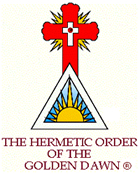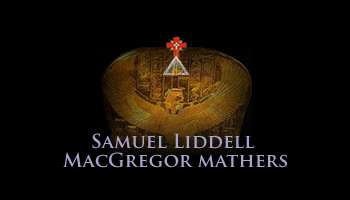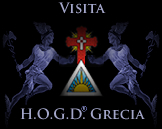Of the three founding members of the Golden Dawn, S. L. MacGregor Mathers has been simultaneously the most vilified and the most deified. Both views are off the mark, for Mathers was neither a villain nor a superhuman god. He was, however, one of the more colourful characters in the history of the Golden Dawn, displaying many of the assets and liabilities often associated with those who possess magical genius and creativity. A gifted ritualist, Mathers produced some of the finest teachings in the Western Esoteric Tradition, but he was also capable of being an eccentric tyrant. Of the three founding Chiefs of the Order it was Mathers, the primary Chief of the R.R. et A.C., who made the Golden Dawn into a truly magical Order.
Early History
Samuel Mathers was born on January 8, 1854 at 11 De Beauvoir Place, Hackney. His father, William M. Mathers, was a commercial clerk. and died while young Samuel was still a boy. He lived with his widowed mother (maiden name Collins) at Bournemouth until her death in 1885.
Mathers enlisted as a soldier with the First Hampshire Infantry Volunteers. One photograph shows him in the uniform of a lieutenant, although he was never more than a private. His first book was actually a military manual, Practical Instruction in Infantry Campaigning Exercise (1884), which was based on a French military manual and adapted for the needs of the British Army. In addition to his interest in military tactics and warfare, he was also a keen student of boxing and fencing.
After his mother died, Mathers was left impoverished. He moved to London where he lived in at Great Percy Street, King Cross. He was appointed as assistant librarian to Annie Horniman's father, Frederick Horniman, founder of the Horniman Museum and an affluent tea importer. Mathers married Mini Bergson on June 16, 1890 at Chacombe in Oxforshire by Rev. W.A. Ayton, who was a prominent alchemist and member of the Golden Dawn. The Matherses lived at Stent Lodge, Forest Hill, but due to poverty they moved to central London and began to live on Annie Horniman's charity.
In the Preface to her late husband's translation of Knorr von Rosenroth's Kabbala Denudata, Mina (or Moina) Mathers revealed some of what little information was ever printed concerning Samuel's early life, although it does not paint an accurate picture of Mathers' ancestry:
“As a very young boy he was intensely interested in mysticism and symbolism generally. He was educated at Bedford Grammar School, specializing on the Classical side. During his spare moments he collected and made a special study of Celtic tradition and symbolism. This love of Celtic Symbology was inherited from his Highland ancestry. His ancestor, Ian MacGregor of Glenstrae, an ardent Jacobite, after the ‘45 Rebellion went to France and under Lally Tolendal fought at Pondicherry. This ancestor was created Comte de Glenstrae by Louis XV. This French title was inherited by my husband and he always used it when living in France. As a young man he came into contact with Kenneth Mackenzie, with whom he had a strong occult link. Kenneth Mackenzie, author of the Encyclopedia of Masonry, had been a great friend of Bulwer Lytton. After some years of seclusion in the country, where my husband led a student's life in preparation for his future work, he met Anna Kingsford, who introduced him to Madame Blavatsky. Madame Blavatsky invited him to collaborate with her in the formation of her Society. After deliberation, notwithstanding his profound admiration for that remarkable woman, this invitation he was compelled to decline. Their ideals were not entirely the same. At that time he was more in sympathy with Anna Kingsford's ideals of esoteric Christianity and of the advancement of women. Moreover, he was profoundly interested in her campaign against vivisection, in which he vigorously aided her. Three or four years later he was told by his Occult teachers to transfer his center to Paris, where my husband and I lived for the rest of his life. I wish here to record my thanks to my occult masters, and the deepest gratitude to the memory of my husband, comrade and teacher, all of whom have shed such light upon my path.� [i]
Moina's devotion to her deceased husband was admirable, although her version of events was not always reliable. Mathers' supposed highland ancestry and inherited title of Comte de Glenstrae is pure fantasy, and Annie Horniman certainly had a role in the Matherses decision to move to Paris. Moina also exaggerated her late husband's role in the creation of the G.D. while downplaying the roles of Westcott and Woodman , suggesting that the two men aided in the administrative side of this school and its teaching to a certain extent. [ii]
Masonic and Magical History
Mathers was initiated in Freemasonry on October 4, 1877 at Hengist Lodge at Bournemouth. He became a Master Mason on January 30, 1878. While living in Bournemouth, Mathers became attracted to mystical studies due to an acquaintance with Frederick Holland, a keen student of Hebrew philosophy and Qabalah. In 1882, Mathers was admitted into the Societas Rosicruciana in Anglia and within four years he was a member of the S.R.I.A.'s High Council. He also served as Celebrant of the London College. After Dr. Woodman's death in 1891, he was appointed Secretary General of the Society on February, 25, 1892, joining Westcott in the ruling triad. To the Society's Transactions he contributed essays on The Deity in Hebrew Letters; Rosicrucian Symbols; and Rosicrucian Ancients and their Zodiacal Emblems.
In 1887, Mathers was approached by Westcott to flesh out the ritual outlines of the Cipher Manuscript into fully functional initiation ceremonies, and asked to join in a triumvirate of Chiefs for Westcott's new creation, the Esoteric Order Golden Dawn, which was founded on March 1, 1888. Mathers signed the charter for Isis-Urania Temple #3 as Praemonstrator with the same motto he used in the Soc. Ros.: S Rioghail Mo Dhream which is Gaelic for "Royal is My Tribe."� His 7=4 motto was Deo Duce Comite Ferro ('With God as My Leader and the Sword as my Companion').
From 1888 to 1891, the Golden Dawn was primarily a theoretical school which performed the initiation ceremonies of the Outer Order, and taught its members the basics of Hermeticism but no practical magic other than the Lesser Banishing Ritual of the Pentagram. This changed with Mathers' creation of the Second Order, wherein the theoretical knowledge taught in the Outer Order was put into active magical practice by those initiates who achieved the grade of Adeptus Minor and above.
In December of 1891, Dr. Woodman died and no one was chosen to take his place in the Golden Dawn's ruling triad. It was a round this time that Mathers finished a magnificent ritual for the 5=6, (the Adeptus Minor grade), the first grade of the Second or Inner Order of the Ordo Roseae Rubeae et Aureae Crucis , also called the R.R. et A.C., or the “ Order of the Rose of Ruby and the Cross of Gold. With the creation of a functional Second Order, Mathers accomplished a restructuring of the Order and became its primary Chief.
Admission to the Second Order was gained by invitation as well as examination. The work of the Second Order was extensive. Members were required to make and consecrate several magical implements. Mathers created a curriculum and a series of eight examinations which led up to the subgrade of Theoricus Adeptus Minor. He was also responsible for writing several of the Second Order's most important manuscripts, including the Z Formula documents concerning the symbolism of the Neophyte Ceremony and the five systems of magic (invocation, talisman consecration, transformations, divination, and alchemy) known collectively as the "Magic of Light."� Through his research at the British Library, he gained an extensive knowledge of Egyptology as well as Dr. John Dee's Enochian workings. He incorporated Enochian Magic into the Second Order Curriculum� expanding Dee's original workings into a potent system of Magical work.
In the spring of 1892, the Matherses moved to Paris and sent up the Ahathoor Temple #7. Dr. Westcott became the Chief of the Order in England. From Paris, Mathers continued to create new material for the ever-expanding curriculum of the Second Order, but he also pursued other interests such as Jacobite politics. In 1898, Samuel and Moina began working on a series of Egyptian ritual dramas of “The Rites of Isis” which were performed for the public numerous times on the stage of the Theatre Bodiniere on Rue Saint-Lazare.
The problems that developed between Samuel Mathers, Annie Horniman, and the rest of the London Adepts, resulting in the Golden's Dawn's break-up is documented in the History of the Golden Dawn .
Mathers died on November 5, 1918 in the Spanish Influenza epidemic that killed 22 million people worldwide. Moina continued to carry on his work in the Alpha et Omega.
Published Works
Mathers' published works included The Tarot: Its Occult Significance, Use in Fortune Telling, and Method of Play (1888), an examination of the Marseilles deck. He is also known for his translations of a series of grimoires including The Sacred Magic of Abra-Melin the Mage , The Key of Solomon the King and The Grimoire of Armadel . In addition Mathers translated Knorr von Rosenroth's Kabbala Denudata from Latin to English in his The Kabbalah Unveiled .
Endnotes:
[i] Mathers, The Kabbalah Unveiled , pages xii, xiii.
[ii] Ibid, page ix.
Sources
Gilbert, R.A., The Golden Dawn Scrapbook . York Beach, ME: Samuel Weiser, Inc., 1997
Gilbert, R.A., The Golden Dawn, Twilight of the Magicians . Great Britain, The Aquarian Press, 1983.
Greer, Mary K. Women of the Golden Dawn: Rebels and Priestesses, Rochester, VT: Park Street Press, 1995.
History of the S,R.I.A.: A History of Rosicrucian Thought and of the Societas Rosicruciana in Anglia. Privately printed for the S.R.I.A. in 1987.
Howe, Ellic. The Magicians of the Golden Dawn , New York, Samuel Weiser, Inc., 1972.
Küntz, Darcy. The Golden Dawn Source Book , Edmonds, WA: Holmes Publishing Group, 1996.
Mathers, S. L. MacGregor. The Kabbalah Unveiled , York Beach, ME: Samuel Weiser, Inc. 1989.
Biography copyright � 2000 by Soror S.J.
�
�
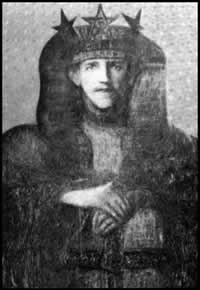
Samuel Liddell Mathers
To students of the Golden Dawn, Mathers is, if nothing else, one of the great Founding Fathers of the Order. An outstanding ritualist with a keen sense of the dramatic, Mathers was responsible both for the rituals and for much of the teaching of the Second Order, but he has been ill-served by his biographer (Ithell Colquhoun) who fleshed out the facts of his private life with a great deal of fantasy. It is ironic that she created her unreal image of Mathers without being aware of the fantastic eulogy that Brodie-Innes wrote for The Occult Review in 1919. As a consequence most Golden Dawn enthusiasts have remained ignorant of its existence and have never read it.
These 'personal reminiscences' could have been a marvelous source for a future biographer, as Brodie-Innes had been close to Mathers for more than twenty-five years, but they are instead a breathtaking display of heroic fantasy, special pleading and downright distortion of the facts. As a Scot, Brodie-Innes would have known that Mathers' claims to a Highland ancestry, and to a grandfather who fought with the French in India, were utter rubbish. As an active member of the Golden Dawn he would have experienced Mathers's paranoia and malice at first hand; and yet he chose to follow the maxim, de mortuis nihil nisi bonum.
His misguided loyalty is, ala, misleading, and it is good to supplement it with another, more objective obituary that also appeared in The Occult Review . A month before Brodie-Innes's 'Reminiscences' were printed, the editorial 'Notes of the Month' included some extensive 'particulars with regard to Mr. Macgregor Mathers', from 'one who knew him well during a certain period of his life'. The anonymous writer (who was A.E. Waite) was not sympathetic to Mathers, but he was at least non-partisan and the picture he paints is of Mathers the man - not of Macgregor the Superman. For once with Mathers we can truly say, magna est veritas et praevalebit . For the benefit of enthusiasts both the fact and the fantasy are printed below.
Fra. In Deo Vita Aeterna
September 24, 1998
�
�
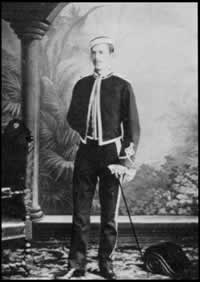
The Occult Review
APRIL, 1919
The following are some particulars with regard to Mr. MacGregor Mathers, from one who knew him well during a certain period of his life.
The death of Samuel Liddell MacGregor Mathers, which took place - at Paris - towards the end of last Novemeber, recalls a host of old memories, and, as it is unlikely that they will be put otherwise on record, I am making these rough notes concerning them for the information of occult readers. They are of necessity personal in nature on both sides. It was in or about 1883 - when I, as a young man, was haunting the British Museum, trying many paths of search - that I observed continually the lean figure of a fellow-student frequenting the Reading-Room and pursuing kindred quests. He was, I am afraid, in very narrow circumstances and was a much more faithful visitor than myself, even in those days. He might be found in the early morning and still late in the evening. The closing time was then 7 or 8 p.m., according to the season, and at those hours he would be seen struggling with mammoth collections of books towards the central counter. I got to know that they were occult books, like my own gatherings, though I kept these within the limits of possible reference in the day's course. It must be confessed that I grew curious as to the identity of this strange person, with rather fish-like eyes, and more especially as to what he was after. Some other melancholy votary of that sanctuary made us known to one another in the end, and he proved to be S.L. Mathers, for the MacGregor prefix had not as yet been adopted. I suppose that we must have spoken of occult books or subjects in one of the corridors, for he said to me in a hushed voice and with somewhat awful accent: "I am a Rosicrucian and a Freemason; therefore I can speak of some things, but of others I cannot speak." I was a younger man than he and a beginner in occult paths, but I remember being amused in two ways - firstly, because I had not been seeking information and, secondly, because - little as I knew at that period about the Rosy Cross and its Brethren - I was very certain that real membership would not have been so ready to parade the fact. However, we got slightly acquainted, and the more I saw of him the more eccentric he proved to be. I remember comparing him in my mind to a combination of Don Quixote and Hudibras, but with a vanity all his own. He would accost me suddenly, to deliver the inspirations of the moment. One of them concerned his great military ardour and his intention to join the French Zouaves in Africa, that he might spend "the rest of his life in fighting, and all that sort of thing." However, the months wore on, and he remained a denizen of the Reading-Room. I met him one morning wearing a scarlet tie, to which he pointed proudly because it was assumed as a symbol of his fighting instincts, which he had proved unable to gratify in any more practical manner. We encountered on another occasion, he staggering as usual under a load of books, and he said: "I have clothed myself with hieroglyphics as with a garment," so I inferred that he was then deep in Egyptology. He had a natural faculty for suggesting in his mystery-language that he had a most profound acquaintance with any subject he took up, and it went a long way with the unversed.
I came across him also occasionally at various occult gatherings of an informal kind - gatherings of people "interested" and mostly of people agape. One met him afterwards in Miss Bergson's society, and it was understood that they had designed to marry. He was at work on Kabalism about 1885 and subsequently translated some texts of the Zohar from the Latin version of Rosenroth. They appeared under the title of The Kabbalah Unveiled , his introduction to which offered marked testimony to a serious study of the arbitrary part of Kabalism - things like gematria and notaricon - but his rendering from the Latin was criticized at great length and in unsparing terms by a writer in The Theosophist. I believe that he replied by affirming that at just those points of alleged mistranslation he had collated the Latin with the original Chaldee texts. But his acquaintance with these can be judged by the fact that he termed Isaac de Loria's treatise De Revolutionibus Animarum a part of the Zohar. It was written some three hundred years later than the latest date to which the most drastic judgement refers that monumental work.
A little earlier than the period of his translation, Mathers had been and remained very active in a certain Rosicrucian Society, which became somewhat too well known afterwards as the Hermetic Order of the G.D. He claimed in a law case long after that he was the chief and head of the Rosicrucian Order; but from the Hermetic Society in question it is known that he was cut off by a large majority vote about 1901. Returning to the earlier period, a time came when Mathers married Miss Bergson, who survives him, and is the sister of Henri Bergson, the now world-famous French philosopher. He was appointed soon after the curator of the Horniman Museum, but the arrangement came to an end in something under two years. A little later Mathers and his wife migrated to Paris, where he continued to live for the most part. Presently he assumed the title of Comte de Glenstrae, affirming that it had been conferred on an ancestor by King James II. At the Arsenal Library in Paris he came upon the French manuscript of a magical ritual by Abramelin the Mage, which purported to be of Hebrew origin, but betrayed itself on every leaf. The attribution was, however, accepted by Mathers, who was of an utterly uncritical mind. He translated it into English and it appeared in a sumptuous form. In addition to this he translated the Clavicula Salomonis (Key of Solomon the King) from originals found in the British Museum, and wrote a booklet on the Tarot.
When he translated his menage to Paris my acquaintance with Mathers came practically to a close, but the tales told concerning him were many and strange. He established a branch of the occult society which I have mentioned and various occult notabilities of France looked in and looked out again. He was a firm believer in the destiny of the Stuart dynasty to regain the throne of England, and rumour accredited him with Young Turkey plottings - conspiracy for the sake of conspiracy, as W. B. Yeats once said about him. I believe that he knew evil days, poor fellow, and tried to retrieve his fortunes in various ways. He had a Temple of Isis at the French Exhibition, and I have even heard of Tarot fortune-telling at Dieppe - to which I hope that he was not really reduced. He had unfortunately no inclination to earn a competency in the ordinary walks of life.
Amidst many weaknesses he possessed of course his good points, a certain sincerity in his occultism - amidst several queer devices - and a considerable fund of undigested learning.
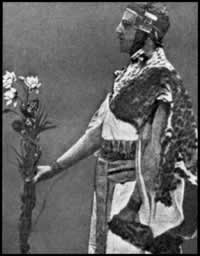
MacGregor Mathers- Some Personal Reminiscences
By J. W. Brodie-Innes
In November of last year, almost unnoticed by the general public, there passed away in Paris a very remarkable man. What was he - a great adept - a great scholar - a great impostor - a great rascal? I have heard all opinions, confidently, even dogmatically, asserted. As many and as contradictory opinions as were pronounced of Cagliostro. I knew him intimately; and perhaps a close friendship of some thirty years may warrant my giving a few personal reminiscences that may help to a better understanding of a most interesting personality. When I first met with him he was in charge of the Horniman Museum at Norwood, and even then the contradictory accounts I heard of him roused keen curiosity. Some eminent achaeologists told me that, from his wonderful learning in strange by-paths of knowledge, there was no man in Great Britain better fitted to arrange and catalogue such a Museum as the Horniman. Others denounced him as a superficial charlatan, whose learning could only deceive the ignorant. His very name was in doubt - was he MacGregor - was he Mathers? Yet even the slightest knowledge of Highland history would solve this. The name Mcgregor was proscribed after the 'Forty-five. His ancestors took what was in effect a by-name - Mo-Athair's - "The Posthumous" - from the infant son of Alastair Macgregor of Glenstrae, who, born after the murder of his father in 1603, was installed as Chief of Glenstrae. This name was anglicized into Mathers, which was borne by his ancestors. But the true name was, of course, MacGregor. His grandfather had fought with great gallantry at the siege of Pondicherry, with Lally Tollendal, and received from Louis XIV the title of Count MacGregor de Glenstrae, afterwards confirmed by James II, a French title which naturally was not used in England.
As soon as I came to know him well the mystery of the varying opinions with regard to him was apparent. MacGregor was a Celt of the Celts, a type which no Englishman of the Teutonic strain has ever yet been able to understand or to appreciate.
To very many indeed this type is as a red rag to a bull. There are those to-day who will outdo Dr. Johnson in abuse of everything Celtic or Highland. MacGregor had all the Celtic fiery temper and pride of race. He would pick a quarrel on a point of punctilio, a real, or even a fancied, slight to his clan or nation, and fight it out with the keen zest of a mediaeval knight, but always at a disadvantage, for he was above all a chivalrous Highland gentleman, and in all his nature was not one grain of malice, but among his opponents were some who disdained bot the use of very underhand weapons - any stick good enough to beat a dog. Such a nature, familiar to me as a Celt, was incomprehensible to the average Saxon. Vanity doubtless he had, but it was the harmless vanity of a child. Credulous too, and liable sometimes to be taken in by an impudent impostor, for he who hated deceit was slow to suspect it in another; but unsparing in his denunciation when he found it.
Of his scholarship it is not for me to speak, so far was it beyond my own, yet I know it was as frankly acknowledged by some competent authorities, as it was bitterly denied and depreciated by his opponents. I once showed some of his letters to me on the Kabalah to my own first teacher in Hebrew, a Rabbi and an advanced Kabalist, and he said "that man is a true Kabalist. Very few Gentiles know as much, you may follow him safely." When he arranged a Temple of Isis for the Paris Exhibition, an Egyptologist whose name is world-famous said "MacGregor is a Pharaoh come back. All my life I have studied the dry bones; he has made them live." These are but two examples out of many. Yet there have been those who have said that his Kabalah and Egyptology were shallow and superficial, a rehash of other men's work. Who shall decide? Yet I do know that many questions I asked him were answered at once, and satisfactorily, with abundant citation of authorities, showing intimate acquaintance with the subject, and never have I detected a mistake.
This is not the place to retell how he was taken in by the famous (or infamous) Horus pair. The story is well known, and the trial may be read by the curious; - that he should have been thus deceived is an instance of the faults of his qualities.
Of his occult knowledge and power I can speak more confidently. He had the rare gift of making clear-cut and luminous those deep inner teachings, so often veiled in nebulous vapourings and prolix verbiage, wherein one plods through leagues of slush to pick out a few gems. His astrological knowledge was exceptional, as is abundantly proved by many horoscopes that have passed through my hands, in which the accuracy of his judgement as evidenced by events was convincing. He had also the second-sight of his race developed to a remarkable degree. Of this I have had many proofs. Ceremonial magic of many ages and countries was familiar to him, and I have been told by eminent scientists that his explanations of the power and effect of ceremonial were clear and logical.
That he was the head of a Hermetic Rosicrucian Order is well known. But of this nothing can be said. The pledge was given in full in the Horus trial. All members were bound by a solemn oath to divulge nothing concerning the Order, or its members, or what took place at its meetings. Anything therefore that has been published as to this Order can only have been obtained by the wilful perjury of some member, or evolved from the imagination of the narrator. I may, however, say of my own knowledge that, in spite of dissensions and secessions in the past the Order has gone on and flourished. It has spread over many lands, and the loyalty and affection of its members for their chief was probably greater at the time of his death than ever before.
For many years he lived in Paris, and while in France he naturally and properly used his French title, which he had dropped while resident in this country.
Seldom, I suppose, has a man inspired such love and devotion, and such deadly animosity. For myself I can but speak of him as I knew him, the true and loyal friend of well-nigh half a lifetime. Often I have written to him some question relating to my own literary work, and with unselfish readiness he has laid aside other work to search the Paris libraries and museums, and copy or translate page after page from MSS. Inaccessible to me, or frankly to place at my disposal the stores of his strange learning and his patient researches. I was not blind to his faults, which lay on the surface, and were patent to all. Yet seldom, I think, has a man had a more faithful and cordial friend through many changes of sunshine and shadow than I had in MacGregor Mathers.
Dear, impulsive, hot-headed, warm-hearted Highlander, he had all the defects and the qualities of his race; misunderstood, reviled; and revered, brave and loyal to the last, bearing no malice to any, scarcely even resenting the many baseless falsehoods freely circulated about him, I am glad of this opportunity to add this one little leaf to the wreath laid on the tomb of my dead friend.
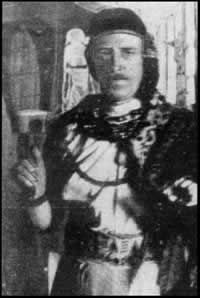
�
Many thanks to www.hermeticgoldendawn.org for permission
to replicate this article
Copyright � 2000 di Soror S.J.
Copyright � 2000 Soror S.J.
Article reproduced by kind permission of The Hermetic Order of the Golden Dawn�
Original article may be found at:
http://www.hermeticgoldendawn.org
|



